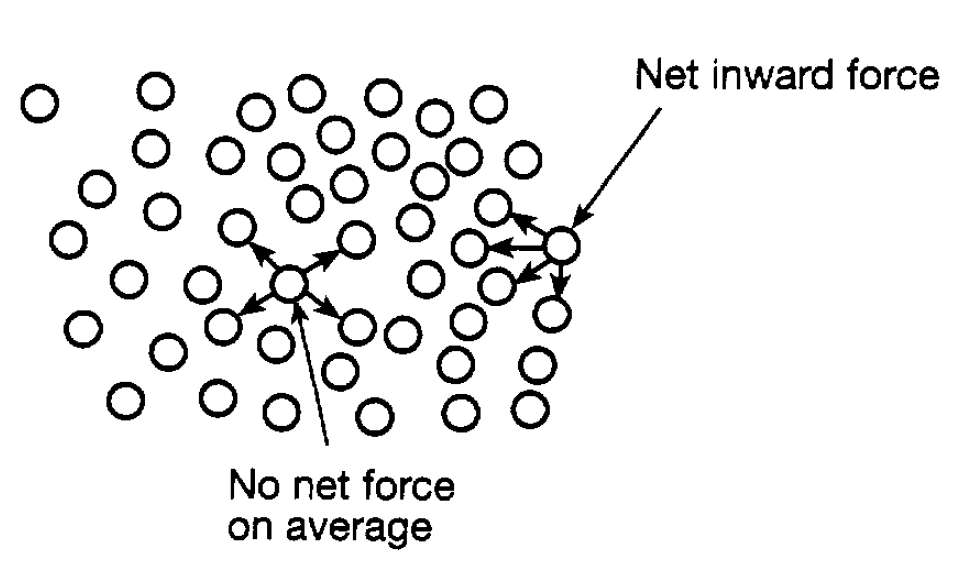


 الفيزياء الكلاسيكية
الفيزياء الكلاسيكية
 الكهربائية والمغناطيسية
الكهربائية والمغناطيسية
 علم البصريات
علم البصريات
 الفيزياء الحديثة
الفيزياء الحديثة
 النظرية النسبية
النظرية النسبية
 الفيزياء النووية
الفيزياء النووية
 فيزياء الحالة الصلبة
فيزياء الحالة الصلبة
 الليزر
الليزر
 علم الفلك
علم الفلك
 المجموعة الشمسية
المجموعة الشمسية
 الطاقة البديلة
الطاقة البديلة
 الفيزياء والعلوم الأخرى
الفيزياء والعلوم الأخرى
 مواضيع عامة في الفيزياء
مواضيع عامة في الفيزياء|
Read More
Date: 8-12-2016
Date: 5-2-2021
Date: 16-7-2017
|
liquids and their Behaviour
Liquids, as was indicated, are intermediate in structure between solids and gases. They have properties of both: for example, densities akin to those of solids but the same lack of rigidity as gases. The constituent molecules are not tightly bound together as in solids, neither are they virtually completely free as in gases. For these and other reasons, although their general behaviour can be understood qualitatively in terms of their structure, it has proved difficult to obtain very precise understanding; liquids are a very complicated form of matter. Sometimes their properties can be understood by regarding them as a modified solid, sometimes as a modified gas and sometimes as a liquid sui generis. In the following we just consider two important properties in a little detail.
Vaporization. If a liquid is in a partially filled container from which all the air has been evacuated, some of the molecules of liquid will occupy the space above the liquid in the form of vapour which will, of course, exert a pressure (vapour pressure) on the surface of the container. Evaporation is said to have taken place and can easily be understood. The liquid particles are moving around in the liquid with all sorts of kinetic energies, the average energy being dependent on the temperature. Some will be moving so fast that they can overcome the restraining intermolecular force and escape into the space above. The most energetic molecules escape, so leaving lower-energy molecules behind and a resultant lower temperature. (This effect is enhanced in our everyday experience when the escaping molecules from our bodies are removed by a wind leading to the ‘wind-chill’ factor frequently referred to in weather forecasts.) Returning to the liquid, some of the escaping molecules will also be ‘recaptured’ and, eventually, an equilibrium situation is established when as many escape as are being recaptured. The higher the temperature the higher the kinetic energy and so the more escape until, at a sufficiently high temperature (boiling point), all the liquid can be converted into vapour. The amount of heat that has to be supplied to achieve this is known as the latent heat of vaporization and is very like the latent heat of sublimation.
Surface Energy. A molecule in the bulk of a liquid is subject, on average, to no net force because it is surrounded on all sides by other molecules. However a molecule in the surface of a liquid experiences a net inward force due to the attraction of the particles immediately below the surface. This means that to increase the surface area of a liquid requires the expenditure of energy in order that molecules moving to the surface can overcome this net inward force. Conversely, the equilibrium situation the situation of lowest energy for a liquid is one in which the liquid reduces its surface area to a minimum. This propensity of a liquid then accounts for the phenomenon of surface tension, the resistance experienced when trying to increase the surface area of a liquid; for example, when blowing a bubble. This effect is also the reason why a tiny amout of liquid tends to form itself into a spherical drop, the shape with minimum surface area, rather than spreading out into a thin layer with a much larger surface area. It should be noted that both surface energy and latent heat of vaporization are related to the strength of the intermolecular force and, for this reason, these two quantities are very roughly proportional to each other.

Figure 1.1: Forces on molecules in the bulk and in the surface of a liquid.



|
|
|
|
للعاملين في الليل.. حيلة صحية تجنبكم خطر هذا النوع من العمل
|
|
|
|
|
|
|
"ناسا" تحتفي برائد الفضاء السوفياتي يوري غاغارين
|
|
|
|
|
|
|
نحو شراكة وطنية متكاملة.. الأمين العام للعتبة الحسينية يبحث مع وكيل وزارة الخارجية آفاق التعاون المؤسسي
|
|
|